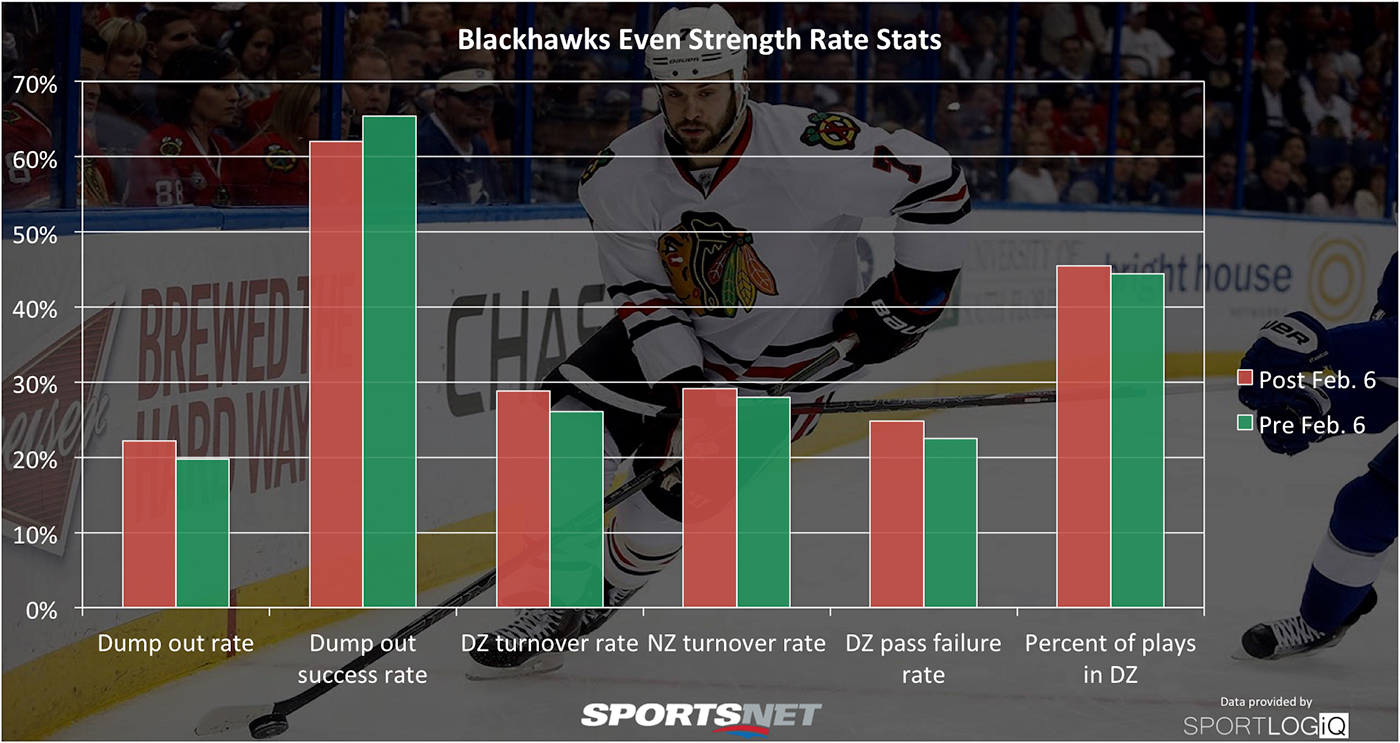The Chicago Blackhawks are a salary cap era dynasty, winning three times in the past six year and in the running for a fourth. However, this season’s Blackhawks find themselves in a position they’ve never been in before: declining as a possession team.
Looking at the past three seasons for the Hawks, this becomes shockingly clear.
Only for a very short period this season have the Blackhawks sustained even the low end of last season’s Corsi numbers. And many believed last year’s team coasted most of the way through the season. They are still an incredibly strong team, but for the first time in years, Chicago has had a sustained amount of time where teams are outshooting them at even strength.
The fall began around February 6, so it makes sense for us to examine what exactly has changed in their inputs, specific kinds of plays, to produce a poor output in terms of Corsi.
The biggest differences for the Blackhawks in this stretch have been in their defensive zone play and transition play. In both of these areas they were among the league’s elite when they are at their best, but they’ve significantly fallen off.
The changes may look small on the surface, but all those little dips add up to big drops in a league that has so much parity.
The Blackhawks have been absolutely clinical when it comes to removing the puck from opponents’ sticks, especially in their own zone, racking up high per-minute numbers despite not spending very much time in their own zone overall. However, since February 6, the Blackhawks have fallen off into the average team range, despite spending more time in their own zone, and especially more time defending.
The Blackhawks have also fallen a fair amount in terms of moving the puck in their defensive zone. They were once one of the league’s most efficient teams in exiting their zone with control, and entering the opponent’s zone, but the Hawks are now solidly in the middle of the pack.
All this comes together in the team’s possession-driving plays, where they’ve gone from best in the league at moving the puck up the ice with control, to around 16th, in the same range as the Ottawa Senators.
Looking at rate stats, we can see the Blackhawks are dumping the puck out of their own zone more often, but they’re also less successful when doing it. The Hawks were never very good at dumping the puck out, with one of the worst success rates in the league, but they’re now significantly worse than the next-worst team. And they’re dumping the puck out more often now, too.
That shift in tactics, which is perhaps not on purpose, has led to the Hawks going from a team that boasted the lowest defensive turnover rate to one that’s in the botto 10 in the NHL. There are similar problems in the neutral zone as well.
Perhaps most frustrating for the Blackhawks is that even when they try to make good plays, they’re not successful as often. Like everything else, the Hawks were extraordinarily efficient when passing in the defensive zone earlier in the year; they had the highest pass success rate in the NHL, but are now down to 21st since early February.
Higher turnover rates, poor decision making, and a lack of success on their plays, has combined to see the Blackhawks struggle at even strength for the first time in years. Fortunately for them, they can still out-talent opponents on most nights, but relying on that to get through four rounds in the playoffs is not ideal.
Maybe by the time the playoffs roll around the Hawks will turn on their second gear and put temporary struggles in the rearview mirror, but this is the weakest this team has looked.
The door is open for others.









